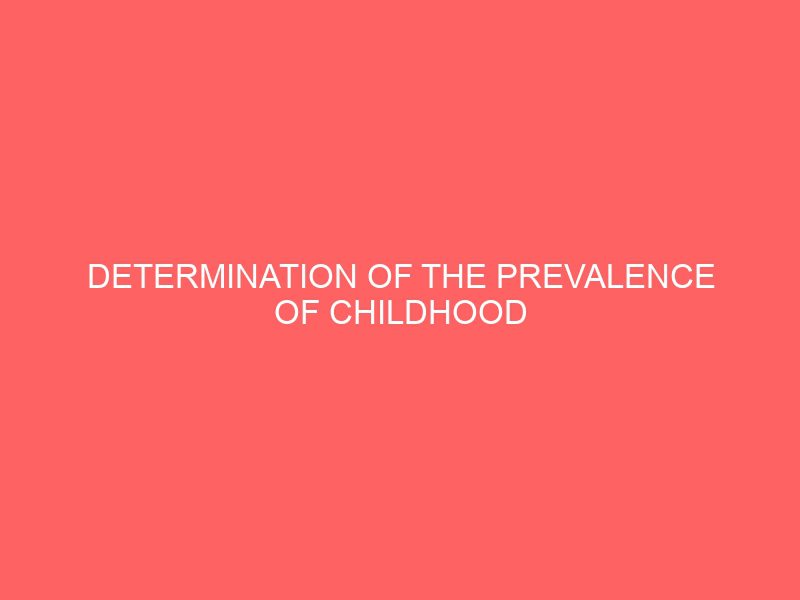Description
CHAPTER ONE
INTRODUCTION
1.1. Introduction
This research is on Determination of the prevalence of childhood malaria in Benue State. Malaria is one of the most important causes of morbidity in the world. It is a vector borne infectious disease caused by a eukaryotic protista of the genus Plasmodium. The disease is transmitted by female Anopheles mosquitoes which carry infective sporozoite stage of Plasmodium parasite in their salivary glands (Akinleye, 2009). It is transmitted from person to person through the bite of a female Anopheles mosquito that is infected with one of the four species of Plasmodium: Plasmodium ovale, Plasmodium falciparum, Plasmodium vivax and Plasmodium malariae. Children under five years and pregnant women are particularly vulnerable to the disease due to their weaker immune systems (WHO, 2000).
Malaria is an acute and chronic disease caused by obligate intracellular Protozoa of the genus Plasmodium. The zoological family Plasmodidae contains protozoan parasites found in the blood of birds, reptiles and mammals (Akinleye, 2009). P. falciparum are found throughout tropical Africa, Asia and Latin America. P vivax is worldwide in tropical and some temperate zones. P. ovale is mainly in West Africa, while P. malariae is worldwide but very patchy in distribution (TDR, 2000). P. falciparum is responsible for about 80% of malaria infection in man and P. vivax is not seen among Africans especially West Africans due to the absence of the Duffy blood group (Afolabi Lesi and Adenuga, 1996).
Malaria does not only affect the health of the child but, it also causes great drain on the national economy. The cost of daily labour coupled with cost of treatment and high mortality associated with the disease make malaria one of the main diseases retarding development in Africa (Ekpenyong and Eyo, 2008). Since many malaria endemic countries are already classified among the poor nations, the disease maintains a vicious cycle of disease and poverty.
Early studies on malaria had focused on vector control and chemoprophylaxis and were done without reference to the behaviour and belief system of the affected population. A different approach was taken in the 1970s with the malaria scourge being tackled through socio-cultural and behavioural research (Jones and Williams, 2004). The early 1990s saw an increase in the number of malaria studies that focused on local terms, perceptions of disease causation, treatment seeking behaviour, prescriber behaviour and preventive measures such as the use of bed nets (Agyepong, 1992; Aikins et al., 1994; Mwenesi et al., 1995; Binka and Adongo, 1997; Muela et al., 1998).
Studies on treatment seeking behaviour have shown that most malaria episodes are first treated at home because there are no nearby health care workers or facilities in many rural areas. Facilities are so far that families have to walk many miles and hours, and even then with no promise of care at the end of their trip. So people often do not even attempt to seek out care, instead they use local remedies or just wait it out (TDR, 2007). As a result of this TDR in 1998 supported research in the training of local mothers and other communities members to recognize fever, provide prepackaged medication, and keep the medicines properly stored and recorded, and this was tagged “Home Management of Malaria (HMM)”. Therefore, studies in HMM has become a cornerstone in malarial case-management and more generally, of malaria control in sub-Saharan Africa (Gypapong and Garshong, 2007).
1.2 STATEMENT OF THE PROBLEM.
Many societies all over the world have had to contend with the consequences of malaria. In Nigeria today, the prevalence of malaria in the hospitals is very high; therefore, it is still the major cause of attendance to out-patient clinics across government hospitals. The PCV and Hb concentration of malaria infected children can be said to be significantly lower than the uninfected while the WBC, SGOT and birilubin of infected children is significantly increased.
Malaria remains a major cause of mortality and morbidity among children under five years of age in Nigeria. Home management of malaria has been identified as a key practice that communities in Africa find beneficial for children`s health. Childhood malaria infection treated at home is based on presumptive diagnosis by mothers/care givers.
1.3 JUSTIFICATION OF THE STUDY
It has been established that children bear the heaviest burden of malaria attack which is either treated at home or in the hospital. Early recognition and appropriate treatment can go a long way in minimizing the outcome of the disease. Previously, WHO (2014) has advocated for the management of malaria infections in the homes by mothers/caregivers before seeking help from any nearby health out let. In the recent time WHO urges endemic countries, donors and malaria partners to adopt diagnostic testing, treatment and surveillance for malaria (WHO,2011). Endemic countries and stakeholders should ensure that every suspected malaria case is tested, that every confirmed case be treated with a quality-assured anti malarial drug, and that every malaria case be tracked in a surveillance system (T3). There is little information in the literature on the effects of different managements of malaria on the blood profile and nutritional status of children in Benue State. It became necessary to verify and compare the hematological, biochemical and nutritional variations associated with home and hospital management of childhood malaria.
1.4 Objectives of the study
The objectives of the study were to:
- Determine the prevalence of childhood malaria in Benue State;
- Assess and compare the impact of home and hospital managements of childhood malaria on hematological and biochemical changes in malaria infected children in Benue State Nigeria;
- Determine the nutritional status of the children with malaria infection and non malaria infected children in Benue State ;
- Assess the knowledge, attitudes and practices (KAP) prevailing amongst mothers/caregivers in the management of childhood malaria in Benue State.
1.5 RESEARCH HYPOTHESES
HYPOTHESIS 1
- H0 : there is no significant relationship between hospital management of childhood malaria on hematological and biochemical changes in malaria infected children in Benue State Nigeria .
- H1 : there is significant relationship between hospital management of childhood malaria on hematological and biochemical changes in malaria infected children in Benue State Nigeria .
HYPOTHESIS 2
- H0 : there is no significant relationship between nutritional status of the children with malaria infection and non malaria infected children in Benue State.
- H1 : there is significant relationship between nutritional status of the children with malaria infection and non malaria infected children in Benue State ;
1.6 RESEARCH METHODOLOGY
The research design is according to Mbachu (2005) a plan or strategy for conducting the research, the design deals primarily with the question to be asked, to whom, how and when. The objective of a proper research design is to obtain as much valid information as quick as possible. This follows the fact that according to Mbachu (2005:109) once the research problem has been adequately formulated to specify the type of information needed, the researcher must work out his research design, as a plan, the research design deals with such things as population of the study, sample size, instrumentation, strategies for data collection etc.
Therefore, for this study, survey design was used to collect, collate and analyze data for this study employing the instrumentation of interview and Questionnaires as the methods for gathering data for this study. This is because according to Jekins, stack and McDermont (2003:4) Survey method is the most appropriate design in communication research that gauges and ascertains the feeling and perception of a cross section of the people on the process and effects of mass communication.”
For this study therefore, the survey research design was adopted to examine the effects of managements of malaria hematological, biochemical and nutritional changes in children in Benue state, Nigeria.
1.7 STATISTICAL ANALYSIS
For the purpose of analyzing and interpreting the data to form inferential knowledge, the variables in the form of questions in the questionnaire are analyzed using frequency tables and simple percentages. Results are derived from each variable by comparing the scores for each of the options in the question. Hence, the following formula is used from frequency counts in the analysis; R = F/T
- Where R stands for research results or finding
- F stands for frequency counts obtained from respondents on each question and options from counts, and
- T stands for total frequency counts obtained from each response of the respondents.
This provides the basis of conclusions and inferences drawn from every question.








Reviews
There are no reviews yet.